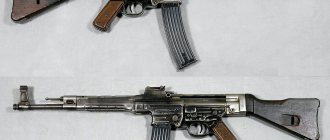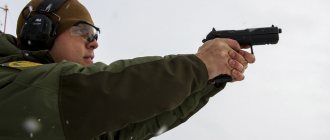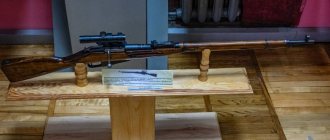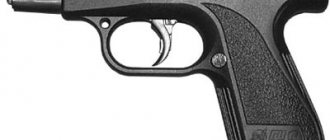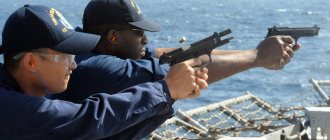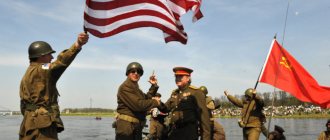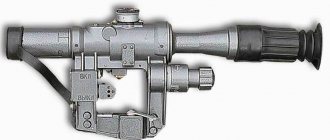Military designers who glorified Russia
Weapons and military equipment have been known since ancient times. During the existence of mankind, hundreds of thousands of weapons have been developed - from a stone ax to an intercontinental missile. A huge role in the creation of weapons belongs to domestic designers. At first, in Russia, firearms (both hand and artillery) were called the same - pishchal. A significant difference in the design of hand and artillery arquebuses arose with the advent of matchlocks at the end of the 15th century. Since the 16th century, hand-held arquebuses with a wheel-flint fuse have been known, which were in service with Russian troops until the 18th century.
In 1856, rifled weapons in Russia received the official name - rifle. In the same year, the first Russian six-line (15.24 mm) rifle was adopted. But practice has shown the advantages of small-caliber rifles. Therefore, in 1868, a small-caliber rifle was adopted by the Russian army. It was developed by Russian military engineers A.P. Gorlov and K.I. Ginius with the assistance of the American Colonel X. Berdan. In America, the Berdanka was rightly called the “Russian rifle.”
The patriarchs of the domestic shooting business were S.I. Mosin, N.M. Filatov, V.G. Fedorov. It was they who trained such famous gunsmith designers as P.M. Goryunov, V.A. Degtyarev, M.T. Kalashnikov, Ya.U. Roshchepey, S.G. Simonov, F.V. Tokarev, G.S. Shpagin et al.
Sergei Ivanovich Mosin
The author of the famous three-line rifle of the 1891 model was Sergei Ivanovich Mosin. For the creation of a rifle, distinguished by excellent tactical and technical characteristics, Mosin was awarded the Great Mikhailovsky Prize - the most prestigious award for inventions in the field of artillery and weapons. For Russian inventors, the Mosin three-line rifle became the foundation for research in the field of automatic small arms.
One of the talented creators of domestic weapons, Ya.U. Roshchepey made the first sample of a rifle “from which you can shoot automatically.”
The modernized Mosin rifle was put into service in 1930. On its basis, the designers developed a sniper version and a carbine, which had the same design principles as the 1891/1930 model rifle. It was only in 1944 that production of the Mosin rifle was discontinued. Thus, more than 50 years passed from the first sample manufactured at the Tula Arms Factory on April 16, 1891 to the last. No small arms system in the world has known such longevity.
But the life of the three-ruler did not end there either. After the Great Patriotic War, designers of sporting weapons, using the excellent tactical and technical capabilities of the three-line rifle, created the MTs-12 small-caliber rifle and the MTs-13 arbitrary 7.62 mm rifle. These models have become one of the world's best models and allowed our athletes to win the highest awards at the Olympic Games, World Championships and other major competitions.
Vladimir Grigorievich Fedorov
An outstanding developer of domestic automatic weapons was V.G. Fedorov. In the spring of 1911, Fedorov's automatic rifle passed the first test, and in the summer of 1912 it passed field tests. At the same time, the F.V. rifle, which performed well, was tested. Tokarev. Along with domestic systems, eight foreign samples were also tested, but none of them were assessed positively. This was a great victory for the Russian school of machine gunsmiths. But with the outbreak of the First World War, by government decision, work on improving automatic rifles was stopped. Only in 1916 was it possible to equip a special unit with machine guns and send it to the front. This was the first submachine gunner unit in the history of wars. At that time, no army in the world had them. At the end of the war, aviation began to be armed with Fedorov’s automatic systems.
One of Fedorov’s students and associates was V.A. Degtyarev. In 1927, a machine gun was adopted by the Red Army, bearing the DP brand - “Degtyarev, infantry”. After this, Degtyarev began working on the creation of a domestic machine gun for aviation. In March 1928, the Degtyarev aircraft machine gun was accepted for mass production and replaced the English Lewis machine guns in Soviet aviation. Degtyarev worked closely with other talented designers - G.S. Shpagin and P.M. Goryunov. The result of their cooperation was a whole series of machine guns. In 1939, a 12.7-mm heavy machine gun of the 1938 model DShK (Degtyarev - Shpagin, large-caliber) entered service. At first it was intended for infantry, but then found application in other branches of the military. Penetrating armor up to 15 mm, the DShK was an effective weapon in the fight against enemy aircraft.
Vasily Alekseevich Degtyarev
When the Great Patriotic War began, Degtyarev was in his seventies. But the designer sought to help front-line soldiers by creating new types of weapons. Since the enemy was strong in tanks, effective means of combating them were urgently needed.
In a very short time, two prototypes of anti-tank rifles were prepared - Degtyarev and Simonov. The Simonov gun had an advantage in rate of fire, while the Degtyarev gun had an advantage in weight and ease of action. Both guns had good fighting qualities and were put into service.
The cooperation between V.A. developed in a special way. Degtyareva with P.M. Goryunov. The young designer created a machine gun that was superior to the machine gun of the Degtyarev system and was recommended by a special commission for adoption. For Vasily Alekseevich this was a surprise and a serious moral test, but when asked which machine gun to adopt, Degtyarev did not hesitate to answer that the heavy machine gun of the Goryunov system should be adopted. The eminent designer in this case showed true nobility and a truly state-like approach.
In May 1943, a new heavy machine gun was put into service under the name “7.62-mm heavy machine gun of the Goryunov system, model 1943 (SG-43).” Front-line soldiers immediately appreciated the high maneuverability of the weapon, simplicity of design, reliability and reliability, relatively light weight, and simplified preparation for firing compared to the Maxim.
The experience of combat use of the Goryunov heavy machine gun and its remarkable combat qualities attracted the attention of tank weapon designers. Soon the decision was made to use the machine gun on medium tanks and armored personnel carriers.
Premature death did not allow the talented designer to realize many of his plans. State Prize P.M. Goryunov was awarded posthumously.
Fedor Vasilievich Tokarev
F.V. was also a talented and original designer. Tokarev. The “Patriarch of Russian weapons” successfully competed with foreign designers - Browning, Mauser, Colt, Nagant and others. Tokarev created about 150 different types of weapons. He is one of those who stood at the origins of domestic automatic weapons. Tokarev first became acquainted with automatic weapons in 1907. A year later he was firing automatically from a rifle of his own design. In 1913, the Tokarev rifle passed regular tests, ahead of the best foreign models of Browning and Sjögren.
In Soviet times, Tokarev improved the Maxim 1910 model and designed several types of aircraft machine guns. The designer’s great merit is the creation of the TT pistol in the pre-war years.
But the main achievement in Tokarev’s creative life was an automatic rifle. In May 1938, Tokarev presented what he considered to be the best of the 17 rifle models he created. As a result of testing, his rifle showed high quality and was adopted for service under the name “7.62-mm self-loading rifle of the Tokarev system, model 1938 (SVT-38).” The designer worked on its creation for 30 years. On the basis of this rifle, in the same year Tokarev developed a sniper rifle with an optical sight.
Creation of G.S. Shpagin's famous submachine gun (PPSh-41) was preceded by long work on many automatic weapon systems together with V.G. Fedorov and V.A. Degtyarev. This was an important stage in the development of the future designer. The PPSh had undeniable advantages over existing models. The first batch of machine guns was tested at the front, directly in battle. The results exceeded all expectations. The commanders asked to quickly establish mass production of Shpagin assault rifles.
The simplicity of the design and manufacturing technology of machine guns made it possible already in 1941, when some military factories were dismantled and transferred to the east, to launch their production in small enterprises and even in workshops. The PPSh deprived the enemy of the advantage over our army in automatic small arms.
A.I. made a significant contribution to the improvement of domestic small arms. Sudaev. World famous M.T. Kalashnikov considers the Sudaev submachine gun (PPS) “the best submachine gun of the Second World War.” Not a single sample could compare with it in terms of simplicity of design, reliability, trouble-free operation, and ease of use. Sudaev's weapons were very loved by paratroopers, tank crews, scouts, and skiers. To manufacture PPS, it required half the metal and three times less time than for PPS.
In the forefront of gunsmith designers A.I. Sudaev appeared unexpectedly and quickly. Already at the beginning of the Great Patriotic War, he developed a project for a simplified anti-aircraft gun, and then began working on the creation of a submachine gun. The officer ensured that he was sent to besieged Leningrad and took part directly there in organizing the production of weapons.
The machine gun of Doctor of Technical Sciences, Lieutenant General Mikhail Timofeevich Kalashnikov (1919) is known throughout the world. It is lightweight, compact, reliable, and elegant.
Senior Sergeant M.T. made his first sample. Kalashnikov was made in the locomotive depot where he worked before the war, and at that time was on leave after being seriously wounded and shell-shocked. At the beginning of the war, Mikhail Timofeevich was a tank driver and saw that the tank driver, having jumped out of the damaged vehicle, no longer participated in the battle. The need to arm tank crews with compact, convenient automatic weapons was obvious.
In the spring of 1942, the prototype was ready. However, the homemade machine gun was rejected “for lack of advantages over existing models.” But the commission noted the extraordinary abilities of the senior sergeant, who set a goal for himself: the machine gun must certainly be much better than all existing models.
Mikhail Timofeevich Kalashnikov
The next tests of the new machines took place in traditionally harsh conditions. One after another, the competitors “left the race”, unable to withstand the most difficult tests. The Kalashnikov assault rifle withstood everything, was recognized as the best and was put into service under the name “7.62-mm Kalashnikov assault rifle, model 1947.” Kalashnikov is also responsible for the design of a 7.62 mm single machine gun chambered for a rifle cartridge (1961). Subsequently, a team of designers under the leadership of Kalashnikov created a number of modifications of automatic small arms. The 7.62 mm modernized assault rifle (AKM), 7.62 mm light machine gun (RPK) and their varieties were adopted for service. In 1974, AK-74 and AKS-74 assault rifles, RPK-74 and RPKS-74 light machine guns chambered for a 5.45 mm cartridge were created. For the first time in world practice, a series of unified models of small arms appeared, identical in principle of operation and a unified automation scheme. The weapon created by Kalashnikov is distinguished by its simplicity of design, high reliability and efficiency; it is used in the armies of more than 50 countries.
Russian artillery also has a remarkable history , the appearance of which is associated with the name of Grand Duke Dmitry Donskoy (1350-1389). It was under him that the cannon foundry business was born.
Russian artillery developed quickly and independently. This is confirmed by its numbers. By the end of the 14th century, there were up to 4 thousand artillery pieces in Rus'.
In the middle of the 15th century, under Ivan III, “cannon huts” appeared, and in 1488-1489 the Cannon Yard was built in Moscow. In the workshops of the Cannon Yard, Andrei Chokhov in 1586 cast the largest caliber cannon in the world, its weight is 40 tons, caliber is 890 mm. Currently it is located on the territory of the Moscow Kremlin. The cannon yard was rich in the talents of other foundry masters. Entire “cannon” dynasties and schools appeared. On the squeak of 1491 it was cast that it was made by “Yakovlev’s disciples Vanya and Vasyuk.” The gunners Ignatius, Stepan Petrov, Bogdan Pyatoy and others are known for their successes.
At the beginning of the 17th century, Russian craftsmen made a three-inch bronze arquebus with rifling in the bore. It was the world's first rifled weapon, more than 200 years ahead of the development of artillery technology in other countries. Other evidence has reached our time that advanced technical ideas existed in Russian artillery of that period. Foreigners knew about this and sought to obtain samples of Russian weapons.
After the Northern War, the chief of Russian artillery, Y.V. Bruce wrote to Peter I: “The British fell in love with Siberian cannons... and are asking for one cannon as a sample.”
Andrey Konstantinovich Nartov
The developed industrial base and the talent of domestic designers allowed Peter I to create artillery, which throughout the 18th century remained the most numerous and technically advanced artillery in the world. The famous Russian mechanic A.K. made a great contribution to the development of domestic artillery. Nartov, who in the second quarter of the 18th century created special machines and tools for the production of artillery pieces, was the first in the world to propose an optical sight. However, the most famous invention of A.K. Nartov had a 44-barreled circular rapid-fire battery. 44 bronze mortars were placed on a wheel-shaped machine, divided into 8 sectors of 5-6 barrels each. The design made it possible to fire from all mortars in the sector simultaneously. Then the machine was turned, fired from another sector, and at this time reloading could be done from the opposite side.
A major contribution to the development of Russian artillery was made by Pyotr Ivanovich Shuvalov (1710-1762). Under his leadership, Russian artillery officers M. Danilov, M. Zhukov, M. Martynov, I. Meller, M. Rozhnov in 1757-1759. developed several samples of smooth-bore howitzers for firing with flat and mounted fire. These weapons, depicting a mythical beast with a horn in its forehead, were called “unicorns.” Light and maneuverable guns fired buckshot, cannonballs, explosive grenades, and incendiary shells at a range of up to 4 km. After Russia, unicorns were adopted first by France, then by other European countries and remained in service for over 100 years. Russian artillery already in those days accompanied the infantry in battle and fired over their battle formations.
Mikhail Vasilyevich Danilov (1722 - 1790) made a great contribution to the improvement of artillery and pyrotechnics. He invented a 3-pound gun with two barrels, called “twins.” He prepared and published the first Russian artillery course, as well as a manual for the preparation of fireworks and illuminations, in which he gave brief information on the history of pyrotechnics in Russia.
Vladimir Stepanovich Baranovsky
In 1872-1877 artillery engineer V.S. Baranovsky created the first rapid-fire artillery gun and used cartridge loading on it. Unfortunately, the talented designer died tragically during artillery tests. None of the foreign guns could surpass the domestic three-inch gun of the 1902 model, created according to Baranovsky’s ideas by professor of the Mikhailovsky Artillery Academy N.A. Zabudsky.
Russian engineers showed great skill in creating powerful projectiles. Thus, the high-explosive grenade V.I. Rdultovsky appeared in artillery in 1908 and, under the name of the “old high-explosive grenade,” survived until the Great Patriotic War.
Artillery was called the “God of War” during the Great Patriotic War. Before the war, Soviet designers of artillery systems created quite powerful and sophisticated guns and mortars. 76-mm cannon designed by V.G. Hitler's artillery consultant, Professor Wolf, considered the Grabin "the best 76-mm gun of the Second World War" and one of "the most ingenious designs in the history of barrel artillery." Under the leadership of Grabin, a 57-mm anti-tank gun, which knew no equal, was created before the war, as well as a powerful 100-mm anti-tank gun. The 152-mm howitzer designed by F.F. was very effective during the war. Petrova.
Vasily Gavrilovich Grabin
In 1943, about half of all artillery weapons of the Red Army were mortars. Many of them were developed under the leadership of B.I. Shavyrina. These are 50-mm company, 82-mm battalion, 120-mm regimental mortars. In October 1944, a 240 mm mortar appeared. Germany lagged behind the USSR in the creation of such powerful mortars. Only in 1942, using drawings captured from one of the factories in Ukraine, German engineers began production of 122-mm mortars, which were an exact copy of the Soviet ones.
From the second half of the 17th century, rockets began to be used in Rus'. At the end of the 17th century, the young Tsar Peter was also involved in the production of rockets. He founded a special “rocket establishment”, where Peter himself manufactured and launched rockets, and came up with compositions of “fire projectiles”. Peter’s signal flare existed in the army for almost a century and a half. In subsequent years, missile technology in Russia is constantly being improved: new missile shells and launchers are being created, and the basics of missile firing are being developed. The initiator of these cases was Alexander Dmitrievich Zasyadko. Zasyadko’s work was successfully continued by Konstantin Ivanovich Konstantinov. Rockets of his design were used in the Crimean (Eastern) War of 1853-1856.
Subsequently, domestic rocket systems were continued in the famous Katyushas and other multiple launch rocket systems. The developers of new design ideas were domestic scientists N.I. Tikhomirov and V.A. Artemyev. Back in 1912 N.I. Tikhomirov proposed using a missile for military ships. On the basis of the Tikhomirov-Artemyev group and the Moscow group for the study of jet propulsion (GIRD), a jet research institute was formed in 1933. Already in 1939, rocket weapons were first used in the form of aircraft missiles. In 1938, the institute began to develop a installation designed for 24 projectiles of 132 mm caliber.
On June 21, 1941, literally a day before the start of the Great Patriotic War, ground-based rocket launchers were demonstrated to the Government Commission. After the demonstration, a decision was made on the immediate serial production of installations and missiles. Less than a month later, on July 14, 1941, the baptism of fire of a new weapon - the famous Katyusha - took place near Orsha. The formidable weapon was used by the battery of captain I.A. Flerov.
After the war, our scientists I.V. Kurchatov, M.B. Keldysh, A.D. Sakharov, Yu.B. Khariton and others created atomic weapons, and long-range bomber divisions were formed to deliver them. Thus ended the US monopoly on this type of weapon.
In 1959, the Strategic Missile Forces (Strategic Missile Forces) . The creators of intercontinental ballistic missiles, liquid jet engines, control devices and complex ground equipment for them were academicians S.P. Korolev, V.P. Glushko, V.N. Chelomey, N.A. Pilyugin, V.P. Makeev, M.F. Reshetnev, V.P. Barmin, A.M. Isaev, M.K. Yangel and others.
Mikhail Kuzmich Yangel
Thanks to their talent and dedication to their work, launch complexes for medium- and short-range ballistic missiles, the Proton rocket and the Energia-Buran universal space system were created, intercontinental missiles (R-16, R-7 and R-9) and medium-range missiles (R-12, R-14).
A new stage in the technical equipment of the Strategic Missile Forces is associated with the creation and placing on combat duty of the RS-16, RS-18, RS-20 missile systems. In these missile systems, our designers used fundamentally new technical solutions that made it possible to increase the effectiveness of the combat use of missiles and enhance their protection from enemy strikes.
The situation and level of development of military affairs also determined the creation of military space forces. Our scientists and designers have developed a unique military space system that has made it possible to significantly increase the effectiveness of various types of troops and types of weapons. Our military satellites are constantly in space, with the help of which reconnaissance, communications and command and control of troops are carried out, the location of ships, aircraft, mobile missile launchers is determined, weapons are aimed at targets, and other tasks are solved.
of tanks , which began in our country, is very interesting and dynamic In May 1915, a tracked vehicle of the Russian designer A. Porokhovshchikov, armed with two machine guns placed in a rotating turret, was tested at the training ground. This is how a fundamentally new type of weapon appeared - the tank. Since then, intense competition in the world has not stopped for the creation of the best armored combat vehicle, increasing its combat properties - firepower, mobility, security.
Mikhail Ilyich Koshkin
Soviet designers M.I. Koshkin, N.A. Kucherenko and A.A. Morozov created the T-34 medium tank, which became the most popular armored vehicle in the world - more than 52 thousand were produced. This is the only machine that went through the entire Second World War without significant design changes - it was so brilliantly conceived and executed.
American military historian M. Caidin wrote: “The T-34 tank was created by people who were able to see the battlefield of the mid-20th century better than anyone else in the West could.” Since December 1943, an 85-mm cannon was installed on the T-34, and its armor-piercing projectile penetrated 100 mm thick armor from a distance of 1000 meters, and a sub-caliber projectile, from a distance of 500 meters, penetrated 138 mm armor, which made it possible to successfully fight the German “tigers” " and "panthers".
Together with the T-34, our heavy KV and IS tanks, created under the leadership of Zh.Ya., successfully operated against the enemy. Kotin and N.L. Dukhova. Currently, measures are being taken to replace the currently operating T-72 and T-80 tanks with a unified and more advanced T-90 model. The new vehicle has an optical-electronic suppression system, a complex that allows firing a guided missile on the move at a range of 5 kilometers, and a backup fire control system for the crew commander.
The achievements of domestic scientists and designers in the field of shipbuilding . In the middle of the 19th century, the transition from the construction of wooden sailing ships to steam ships began all over the world, and ships made of metal appeared. The Russian Navy is becoming armored.
History has left us with the names of the most famous shipbuilders who were ahead of their time. Particularly interesting is the fate of Pyotr Akindinovich Titov, who became the chief engineer of the largest shipbuilding company and did not even have a certificate of completion of a rural school. The famous Soviet shipbuilder Academician A.N. Krylov considered himself a student of Titov.
In 1834, when the fleet did not have a single metal ship, a submarine made of metal was built at the Alexander Foundry. Its armament consisted of a pole with a harpoon, a powder mine and four launchers for launching missiles.
In 1904, according to the project of I.G. Bubnov, the famous builder of battleships, began the construction of submarines. The Akula and Bars boats created by our craftsmen turned out to be more advanced than the submarines of all the countries that fought in the First World War.
Sergey Nikitich Kovalev
An important role in improving the domestic submarine fleet was played by the Soviet ship designer and inventor, Doctor of Technical Sciences, Academician of the USSR Academy of Sciences Sergei Nikitich Kovalev (1919). Since 1955, he worked as the chief designer of the Leningrad Central Design Bureau "Rubin". Kovalev is the author of over 100 scientific papers and many inventions. Under his leadership, nuclear missile-carrying submarines were created, known abroad under the codes “Yankee”, “Delta” and “Typhoon”.
The Russian fleet was far ahead of foreign fleets in the development of mine weapons. Effective mines were developed by our compatriots I.I. Fitztum, P.L. Schilling, B.S. Yakobson, N.N. Azarov. The anti-submarine depth charge was created by our scientist B.Yu. Averkiev.
In 1913, Russian designer D.P. Grigorovich built the world's first seaplane. Since then, work has been carried out in the Russian Navy to equip ships as carriers of naval aviation. Air transports created on the Black Sea, which could accommodate up to seven seaplanes, took part in combat operations during the First World War.
A prominent representative of domestic ship designers is Boris Izrailevich Kupensky (1916-1982). He was the chief designer of the Ermine-class patrol ships (1954-1958), the first anti-submarine ships in the Soviet Navy with anti-aircraft missile systems and a gas turbine all-mode power plant (1962-1967), the first nuclear-powered surface combat ship in the USSR Navy power plant and the lead in the series of nuclear-powered missile cruisers "Kirov" (1968-1982) with powerful strike and anti-aircraft weapons and an almost unlimited cruising range.
In no other area of Russian design thought are there so many famous minds as in aircraft manufacturing . OK. Antonov, A.A. Arkhangelsky, R.L. Bartini, R.A. Belyakov, V.F. Bolkhovitinov, D.P. Grigorovich, M.I. Gurevich, S.V. Ilyushin, N.I. Kamov, S.A Lavochkin, A.I. Mikoyan, M.L. Mil, V.M. Myasishchev, V.M. Petlyakov, I.I. Sikorsky, P.S. Sukhoi, A.A. Tupolev, A.S. Yakovlev and others created models of airplanes and helicopters that were in mass production for many years, and many of the technical solutions they found are still used in the design of modern aircraft.
Alexander Fedorovich Mozhaisky
The designer A.F. became a true innovator. Mozhaisky, 10-15 years ahead of foreign competitors. Mozhaisky created a working model of the aircraft, which in 1877 was presented to the aeronautics commission. The Russian inventor not only showed in detail the design of the future device, but also demonstrated all the elements of flight: takeoff run, takeoff, flight and landing. Subsequently, Captain Mozhaisky created a life-size aircraft, but the commission gave a negative opinion on Mozhaisky’s airplane and recommended that he abandon the creation of an aircraft with a fixed wing and build it “on the model of birds with flapping wings,” with which the designer did not agree. The first unsuccessful flight tests did not stop the officer, and he persistently improved the airplane until his death (spring 1890).
One of the first Russian aviation designers who glorified domestic science and technology was Ya.M. Gakkel (1874-1945). Between 1908 and 1912, he designed 15 aircraft of various types and purposes. At the same time, he continuously improved the quality of the machines and their flight performance.
A landmark event in the history of aviation took place on May 13, 1913 near St. Petersburg. Igor Ivanovich Sikorsky (1880-1992) took into the air an unprecedented aircraft of his own design. Its weight was four times that of the largest airplane at that time. In terms of carrying capacity, the new machine could only be compared with the largest airships of that time. This truly revolutionary aircraft was the Russian Knight.
For a long time, people abroad could not believe that the Russian aircraft designer had succeeded in what was considered impossible in the West. In 1912-1914, under the leadership of Sikorsky, the Grand and Ilya Muromets aircraft were also created, which were distinguished by their long flight range and laid the foundation for multi-engine aviation.
Andrey Nikolaevich Tupolev
Of great importance in the history of aviation was the creation under the leadership of Andrei Nikolaevich Tupolev (1888-1972) of the world's largest passenger aircraft ANT-20 "Maxim Gorky" (1934), as well as medium and heavy bombers, torpedo bombers and reconnaissance aircraft. Together with N.E. Zhukovsky, he took an active part in the organization of the Central Aerohydrodynamic Institute (TsAGI). Under his leadership, more than 100 different types of aircraft were designed and built, 70 of which were put into mass production. Aircraft TB-1, TB-3, SB, TB-7, MTB-2, Tu-2 and torpedo boats G-4, G-5 were used during the Great Patriotic War. In the post-war years, under the leadership of Tupolev, a number of aircraft were created for the Soviet Army and Navy, civil aviation, including the first Soviet jet bombers Tu-12 (1947), Tu-16; the first jet passenger aircraft Tu-104 (1954); the first turboprop intercontinental passenger airliner Tu-114 (1957) and the subsequent Tu-124, Tu-134, Tu-154, as well as a number of supersonic aircraft, including the passenger Tu-144.
Tupolev trained many aircraft designers, around whom independent design bureaus subsequently formed: V.M. Petlyakova, P.O. Sukhoi, V.M. Myasishcheva, A.A. Arkhangelsky and others.
An outstanding contribution to the development of domestic aviation was made by designers A.S. Yakovlev, S.A. Lavochkin, A.I. Mikoyan, S.V. Ilyushin and G.M. Beriev. In the design bureaus they led, new fighters, bombers, attack aircraft were designed, tested and put into mass production in a very short time, flying boats and ship-borne aircraft were created.
Pavel Osipovich Sukhoi
A talented aircraft designer was Pavel Osipovich Sukhoi (1895-1975). Under his leadership, more than 50 aircraft designs were created, many of which were distinguished by high flight performance and combat characteristics. A multi-purpose aircraft of his design (Su-2) was successfully used during the Great Patriotic War. In 1942-1943, he created the Su-6 armored attack aircraft. Sukhoi is also one of the founders of Soviet jet and supersonic aviation. In the post-war years, the design bureau, under his leadership, developed jet aircraft Su-9, Su-10, Su-15, etc., and in 1955-1956 - supersonic jet aircraft with swept and delta wings (Su-7b, etc.). Aircraft designed by Sukhoi set 2 world altitude records (1959 and 1962) and 2 world speed records on a closed route (1960 and 1962).
In the coming years, the Su-24M front-line bomber will be replaced by the Su-34 multifunctional bomber, which has no analogues in the world. Its main purpose is to hit highly protected point targets at any time of the day and in any weather conditions. The talent and dedication of our scientists and designers make it possible to have such types of weapons that no other army in the world has. So, only Russia has ekranoplanes. The general designer of the first ekranoplanes is R.E. Alekseev. At the end of the 40s, he created a hydrofoil torpedo boat with a speed unprecedented at that time - 140 km/h and high seaworthiness. The subsequent “Rockets” and “Meteors” were the brainchild of a military scientist.
In the West, ekranoplanes were also designed, but after a number of failures they stopped working. In our country, ekranoplanes were created in various versions: attack, anti-submarine, rescue. The ekranoplan with a displacement of more than 500 tons and a speed of 400-500 km/h was tested by the general designer himself. The unique equipment is capable of not only landing for military purposes, but also carrying out peaceful passenger and cargo transportation, and conducting rescue and research work.
The Ka-50 anti-tank helicopter, called the “Black Shark,” also has no analogues. Since 1982, this combat vehicle has won various competitions more than once and amazed specialists at various exhibitions.
The helicopter has powerful weapons. It is equipped with NURS units, Vikhr ATGM launchers with laser beam guidance, and a 30 mm cannon with 500 rounds of ammunition. Missiles are launched from 8-10 kilometers, that is, outside the range of enemy air defense. The pilot's ejection seat and preliminary shooting of the helicopter blades ensure the pilot's rescue over the entire range of speeds and altitudes, including zero.
The Russian land has always been rich in talents; we showed the world Mendeleev and Korolev, Popov and Kalashnikov. The list of outstanding domestic military designers can be continued for a very long time. The sword of the Russian army was forged by the labor and intellect of many hundreds and thousands of our compatriots.
Infantry weapons
The weapons of those times were of different calibers. This introduced significant difficulties into its operation. In Russia, only the dragoon regiments had 17 caliber guns! The situation was even worse in the infantry, where in one regiment there were often guns of four or five different calibers. Along with this, the troops also came across captured weapons that served on an equal basis with domestic ones. There were especially many Prussian and Swedish guns from the Seven Years' War of 1756 - 1763.
The improvement of muzzle-loading flintlock weapons in the early years of the 19th century followed the path of reducing its weight and reducing the recoil effect when fired. First of all, this was achieved by shortening the barrel and greater curvature of the butt. Such improvements in flint weapons increased their performance.
Russian weapons at the beginning of the 19th century were tested in battle during the Patriotic War of 1812. The Russian people, who rose to defend their Fatherland, completely defeated the French invaders. Having defeated Napoleon's army in the battles on the Borodino field, near Tarusa, Maloyaroslavets, Krasny, and on the Berezina, Russian soldiers demonstrated to the whole world outstanding courage, dedication, and ability to wield their weapons.
In Russia, infantry rifles of the 1805 and 1808 models were the most popular small arms. The armament of the infantryman and grenadier of those times was not inferior to many foreign models: French, Prussian, Saxon, Austrian and English.
Rifle
Compared to smooth-bore rifled weapons, they had better accuracy and accuracy of fire, but due to the laboriousness of loading, they were not widely used. For example, in the Jaeger regiments, only 12 riflemen for the entire company were armed with rifled rifles. The last example of such weapons was introduced into Russia in 1805.
Russian percussion rifle model 1854
The inconvenience of using long-barreled rifles in cavalry determined the design features of weapons for this type of troops. Indeed, manipulating a long gun on a horse galloping at full speed is extremely difficult. There was a need for gunsmiths in all countries to create and produce small-sized weapons for cavalrymen. For example, dragoon and cuirassier guns of the 1809 model were only 94.2 cm long, and hussar guns were even shorter - 63.75 cm. Naturally, the shortening of the barrels affected shooting accuracy. Thus, at a distance of 160 steps, only 50% of the bullets hit a target 1.8 × 1.2 m. As the distance increased, the hit percentage decreased rapidly. For example, from 240 steps less than 25% of the fired bullets could hit the target. The effectiveness of the shots was higher only with the cavalry rifle, which was adopted in 1803 by cuirassier, dragoon and uhlan regiments. This was achieved as a result of the correct flight of the bullet, accelerated by powder energy along a rifled barrel, imparting rotational motion to it. The accuracy of such a rifle was twice that of dragoon and cavalry rifles. However, the supply of these weapons to the troops was limited. Thus, in each squadron of cuirassier, dragoon and uhlan regiments, rifles were issued only to 16 privates, while the rest of the soldiers were armed with carbines, rifles and blunderbusses.
Lüttich double-rifled fitting of the 1843 model, which was in service in Russia. Nearby is a bayonet
The mandatory weapon of every cavalryman was a pair of saddle pistols. In battles with Napoleonic invaders, Russian soldiers used a model of a pistol with a flintlock, approved in 1809.



